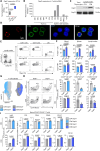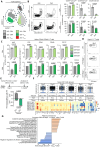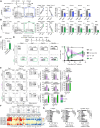A Dapl1+ subpopulation of naïve CD8 T cells is enriched for memory-lineage precursors
- PMID: 40845112
- PMCID: PMC12372879
- DOI: 10.1126/sciadv.adx5687
A Dapl1+ subpopulation of naïve CD8 T cells is enriched for memory-lineage precursors
Abstract
Memory CD8 T cells provide long-lasting immunity, but their developmental origins remain incompletely defined. Growing evidence suggests that functional heterogeneity exists within the naïve T cell pool, shaping lineage potential before antigen stimulation. Here, we identify a subpopulation of naïve CD8 T cells expressing death-associated protein-like 1 (Dapl1) that contains preprogrammed precursors biased toward memory differentiation. The differentiation of these precursors is independent of Dapl1 but relies on the transcription factor B-cell lymphoma/leukaemia 11b (Bcl11b), resulting in the generation of Dapl1+ central memory-like CD8 T cells after infection and stem-like memory cells in cancer. Dapl1+ naïve T cells originate among mature thymocytes and gradually appear in the periphery postnatally. Peripheral Dapl1+ and Dapl1- populations show limited plasticity, supporting a thymic-imprinting model. These findings reveal a developmentally imprinted subset of naïve CD8 T cells committed to memory fate, uncovering an alternative pathway for memory T cell generation offering new avenues for therapeutic application.
Figures






References
-
- Gebhardt T., Park S. L., Parish I. A., Stem-like exhausted and memory CD8+ T cells in cancer. Nat. Rev. Cancer 23, 780–798 (2023). - PubMed
-
- Huang A. C., Postow M. A., Orlowski R. J., Mick R., Bengsch B., Manne S., Xu W., Harmon S., Giles J. R., Wenz B., Adamow M., Kuk D., Panageas K. S., Carrera C., Wong P., Quagliarello F., Wubbenhorst B., D’Andrea K., Pauken K. E., Herati R. S., Staupe R. P., Schenkel J. M., McGettigan S., Kothari S., George S. M., Vonderheide R. H., Amaravadi R. K., Karakousis G. C., Schuchter L. M., Xu X., Nathanson K. L., Wolchok J. D., Gangadhar T. C., Wherry E. J., T-cell invigoration to tumour burden ratio associated with anti-PD-1 response. Nature 545, 60–65 (2017). - PMC - PubMed
MeSH terms
Substances
Grants and funding
LinkOut - more resources
Full Text Sources
Research Materials

